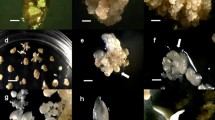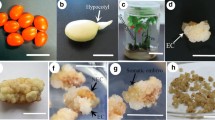Abstract
Stem segments of seedlings from two Alstroemeria breeding lines, cultured on media supplemented with 4 mg/l 2,4-dichlorophenoxyacetic acid and 0.5–1.0 mg/l 6-benzylaminopurine (BA), initiated soft callus, which became compact after subculture on a medium with only 0.5 mg/l BA. Friable embryogenic calli were initiated from compact callus on a medium supplemented with 10 mg/l picloram. Proembryos developed from friable embryogenic calli via embryos into plants after subculture on medium supplemented with 0.1 mg/l BA. The proembryos formed friable embryogenic calli again after culture on medium supplemented with 10 mg/l picloram. The total time needed to regenerate a complete plantlet from friable callus was approximately 6 months. This system for the production of embryogenic material is considered to have valuable applications for genetic transformation in Alstroemeria.
Similar content being viewed by others
Author information
Authors and Affiliations
Additional information
Received: 22 April 1999 / Revision received: 16 July 1999 · Accepted: 20 July 1999
Rights and permissions
About this article
Cite this article
Lin, HS., van der Toorn, C., Raemakers, K. et al. Development of a plant regeneration system based on friable embryogenic callus in the ornamental Alstroemeria . Plant Cell Reports 19, 529–534 (2000). https://doi.org/10.1007/s002990050768
Issue Date:
DOI: https://doi.org/10.1007/s002990050768




